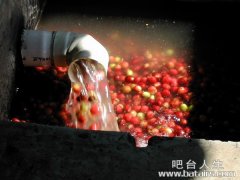Carefully filter "sick problem beans"
Defective beans, as the name implies, are defective beans, bad beans, just like bad apples. There are a variety of reasons and many kinds of coffee. Here is a detailed description of the things that affect the quality of coffee.
A variety of factors can cause defective beans. Defective beans can be produced as large as the growing environment of coffee trees and as small as the process of harvesting and processing raw beans. But do not underestimate these defective beans, if one or even several coffee bars use all defective beans, it will not only affect their own brand coffee culture, it will even affect the market share of the entire coffee chain brand and the reputation of coffee joining the market.
Raw coffee beans will absorb the ingredients contained in the soil where they are planted, and if they contain too much iodine, as in the soil in Rio de Janeiro, Brazil, the final coffee precipitated after adsorption will also have iodine flavor, although it may not be obvious. The climatic conditions of coffee planting land, the amount of rainfall will affect the growth of raw coffee beans, and due to lack of nutrients will also produce stunted coffee beans. Worms can easily cause insect damage to beans when they drill into the coffee fruit to lay eggs. In addition, the growing environment can cause two special defective beans: like beans and round beans. Elephant beans are bigger than ordinary raw beans. Round beans are, as the name suggests, a coffee fruit with only one round seed. When the quantity of these two kinds is small, it will not have much effect on the taste of coffee, but it is best to pick them out by hand, and it is more appropriate to bake them separately when they accumulate to a certain amount.
Next, the author specifically introduces several kinds of defective beans.
Moldy beans: because of incomplete drying, or damp in the process of transportation and storage, cyan and white molds grow, which sometimes make the beans stick together. If these moldy beans are not removed, they will produce moldy smell.
Dead beans: beans with abnormal results. The color is not easy to change because of baking, so it is easy to distinguish. The flavor is thin, as harmful as silver skin, and will become a source of peculiar smell.
Immature beans: beans picked before they are ripe have a fishy, disgusting taste. Leaving raw coffee beans for years is a strategy to deal with these immature beans.
Shell beans: produced by poor dryness or abnormal mating; the beans break from the central line and the inside is turned out like a shell. Shell beans can cause uneven baking and are easy to catch fire during deep baking.
Moth-eaten beans: moths invade and lay eggs when the coffee fruit is ripe and red, and the larvae eat the coffee fruit and grow, leaving traces of moth on the surface of the beans. Worm-eaten beans can cause the coffee liquid to be cloudy and sometimes produce a strange smell.
Black beans: beans that mature early and fall to the ground and ferment and blacken when they come into contact with the ground for a long time. It can be easily removed by hand-selected steps. Coffee mixed with black beans will smell rotten and cloudy.
Shell beans: endocarp covers the inside of the pulp of coffee beans and remains on the washed coffee beans. The poor heat permeability when roasting and sometimes burning is the reason for the astringent taste of coffee. Others include broken beans, red peel beans (beans that rain naturally and taste dull), stunted beans (small grains of beans that stop growing due to lack of nutrients, strong flavor), and sometimes mixed with corn or pepper, and so on.
Stone: beans harvested are easily mixed with stone or sawdust because of natural drying.
Hand selection order:
1. Take the right amount of raw beans and put them in a tray
two。 Select raw beans until they are flawless.
3. Don't just stare at one side of the bean, but pick it up and see its color and shape. Don't miss any one, move your eyes from the right to the left.
4. Repeat the same steps over and over again
5. It is known that the average of picking out defective beans.
Important Notice :
前街咖啡 FrontStreet Coffee has moved to new addredd:
FrontStreet Coffee Address: 315,Donghua East Road,GuangZhou
Tel:020 38364473
- Prev

Good criteria for coffee beans!
At present, there is no clear judgment standard of fine coffee in the international community. Here, we will briefly explain the standards of the American Fine Coffee Association and the basic standards of coffee producing countries. American Fine Coffee Association Standard: 1. Whether it has rich dry aroma (Fragrance). The so-called dry aroma refers to the aroma of roasted or ground coffee. two。 Whether it has rich wet aroma (Aroma).
- Next

Coffee beans are hard to come by.
D2.jpg (75.45 KB, download times: 0)
Related
- Guji coffee producing area of Guji, Ethiopia: Humbela, Shakiso, Wulaga
- What is the most expensive variety of Qiloso in BOP multi-variety group?
- How to store the coffee beans bought home?
- Why are Yemeni coffee beans so rare now?
- Ethiopian Sidamo all Red Fruit Sun Sun Santa Vini Coffee beans
- SOE is mostly sour? What does it mean? Is it a single bean? what's the difference between it and Italian blending?
- Is Italian coffee beans suitable for making hand-brewed coffee?
- How to choose coffee beans when making cold coffee? What kind of coffee beans are suitable for making cold coffee?
- Just entered the pit to make coffee, what kind of coffee beans should be chosen?
- Can only Japan buy real Blue Mountain Coffee? What are authentic Jamaican Blue Mountain coffee beans?

